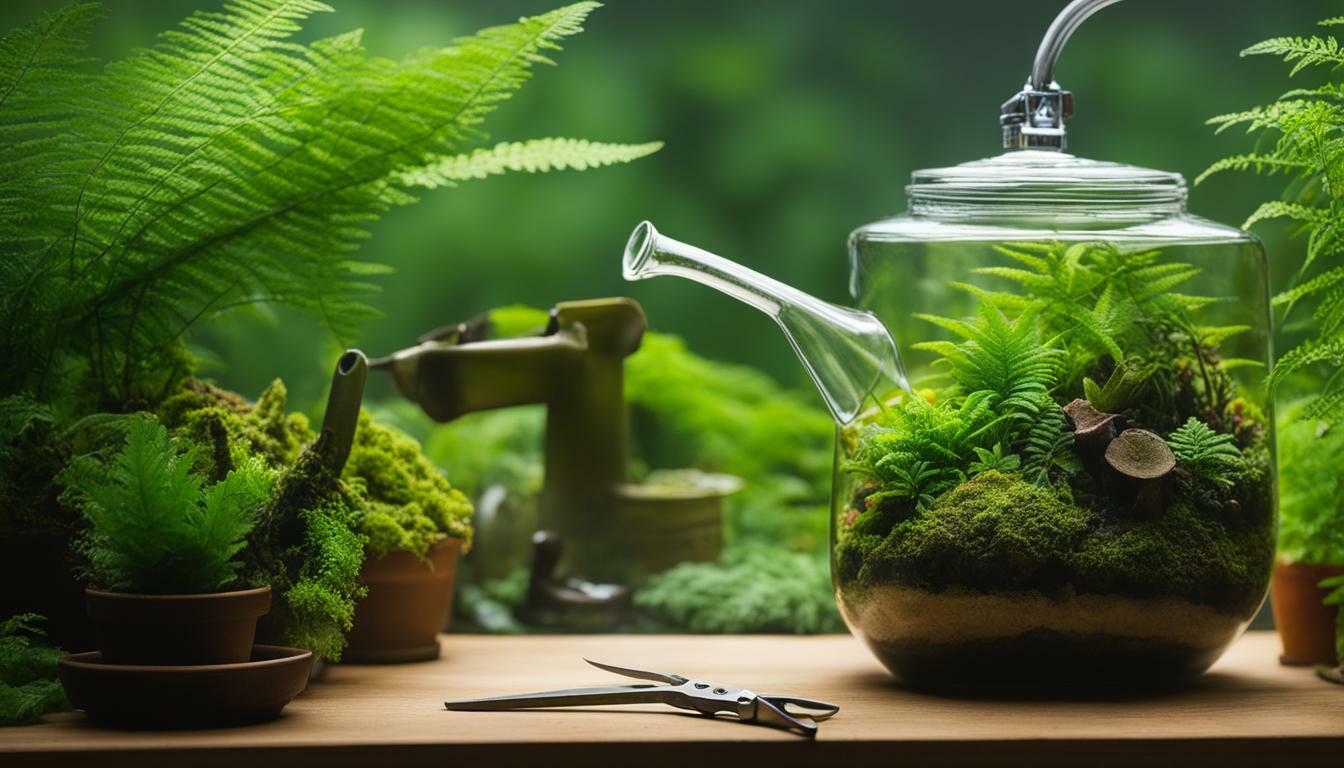Terrariums are mini ecosystems that require regular pruning and trimming to ensure the health and beauty of the plants within. These low-maintenance landscapes offer a unique way to bring greenery into your home, creating a captivating display of nature. However, to keep your terrarium thriving, it’s important to understand the specific care requirements, including the essential practices of pruning and trimming.
- Pruning and trimming are necessary for maintaining the appearance and health of terrarium plants.
- Positioning and lighting requirements differ for open and closed terrariums.
- Proper watering techniques are crucial, with open terrariums requiring weekly watering and closed terrariums being self-watering.
- Regular cleaning of the terrarium glass and addressing pests like fungus gnats are important aspects of terrarium maintenance.
- Sick plants should be promptly removed and replaced to prevent the spread of disease.
By following these tips and understanding the fundamentals of terrarium care, you can create a stunning and thriving mini ecosystem in your home.
Understanding Terrarium Plant Care
Before diving into the pruning and trimming techniques, it’s crucial to understand the essential aspects of terrarium plant care. Terrariums are miniature ecosystems that create little landscapes for house plants. They come in two main types: closed and open terrariums. Closed terrariums have a sealed environment that recycles moisture, while open terrariums allow for more airflow. The positioning and lighting requirements vary accordingly, with closed terrariums preferring indirect sunlight and open terrariums needing bright, indirect light.
Proper watering is a key factor in terrarium plant care. Open terrariums generally require weekly watering, allowing the soil to dry out partially between waterings. On the other hand, closed terrariums are self-watering, creating a humid environment that greatly reduces the need for regular watering. Monitoring soil moisture levels and adjusting watering frequency accordingly is vital to prevent overwatering or underwatering, which can lead to root rot or plant dehydration.
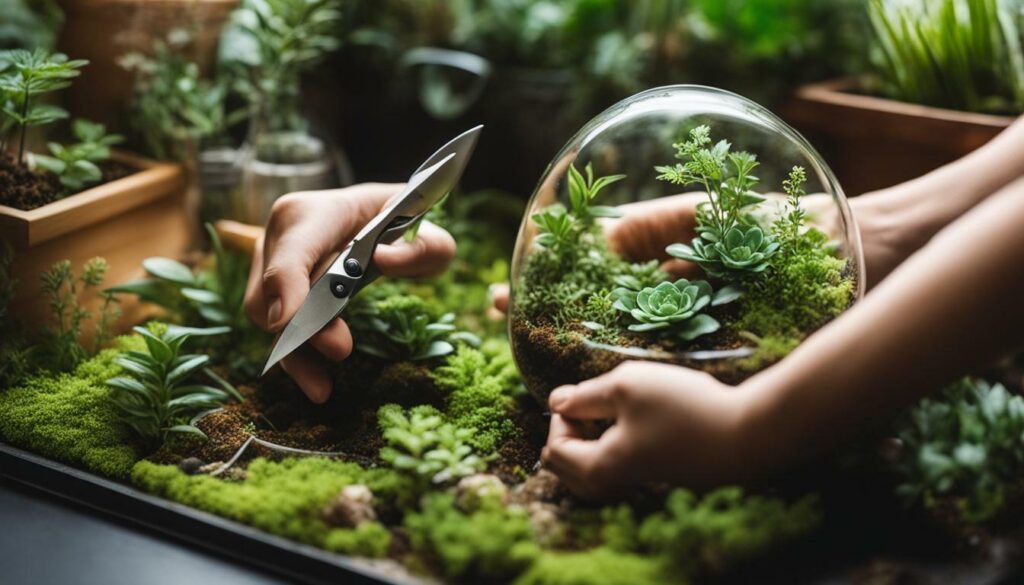
Pruning and trimming play a crucial role in maintaining the health and appearance of a terrarium. Regular removal of dead or decaying plant material helps prevent the growth of mold and fungus, ensuring a clean and tidy terrarium environment. When pruning, it’s important to use clean and sharp tools to make precise cuts. Trimming, on the other hand, involves shaping and controlling the growth of the plants to maintain the desired aesthetic. Proper pruning and trimming techniques will help keep your terrarium looking beautiful and prevent plants from overcrowding.
Apart from pruning and trimming, it’s essential to regularly inspect your terrarium for any sick or diseased plants. Sick plants can quickly spread diseases to healthy ones, impacting the overall health of the terrarium. If you notice any signs of plant illness, such as wilting leaves, discoloration, or unusual growth patterns, it’s important to remove the affected plant immediately. Replace it with a healthy plant to maintain a vibrant and thriving terrarium.
How to Prune and Trim a Terrarium
Pruning and trimming a terrarium can be a simple and rewarding task if done correctly. Follow these steps to ensure the best results. First, gather your equipment: a pair of clean, sharp scissors or pruning shears, a soft cloth for cleaning the glass, and a small brush for removing debris. It’s important to keep your tools clean to prevent the spread of diseases among your plants.
Start by assessing your terrarium and identifying which plants need pruning or trimming. Look for any yellowing or decaying leaves, overgrown branches, or plants that are crowding others. Remove dead or dying foliage by cutting the leaf stem close to the base of the plant. This helps maintain the overall health of the terrarium and prevents the spread of potential diseases.
When trimming overgrown branches, make your cuts just above a leaf or node to encourage new growth. This will keep your plants compact and prevent them from becoming leggy. Avoid cutting too much at once, as it can shock the plant. Instead, opt for gradual, regular trimmings to promote healthy growth.
Tip: Pruning vs. Trimming
In terrarium care, pruning and trimming serve different purposes. Pruning involves cutting back larger branches to control the size and shape of the plant. On the other hand, trimming involves removing small, overgrown parts like leaves or stems to maintain the plant’s aesthetic appearance.
Remember to clean the glass surface of your terrarium regularly to remove any dust or fingerprints. A dirty glass can obstruct sunlight and hinder plant growth. Gently wipe the glass with a soft cloth or use a small brush to reach tight corners.
By following these steps and maintaining regular pruning and trimming practices, you can ensure a healthy, thriving, and visually appealing terrarium that brings beauty and nature into your living space.
| Pruning Tips | Trimming Tips |
|---|---|
| Target larger branches and stems. | Focus on small, overgrown leaves or stems. |
| Make cuts just above a leaf or node. | Remove overgrown parts to maintain plant aesthetics. |
| Prevent the spread of diseases by keeping tools clean. | Avoid cutting too much at once to prevent plant shock. |
| Regular pruning promotes healthy growth and shape. | Regular trimming keeps plants compact and prevents legginess. |
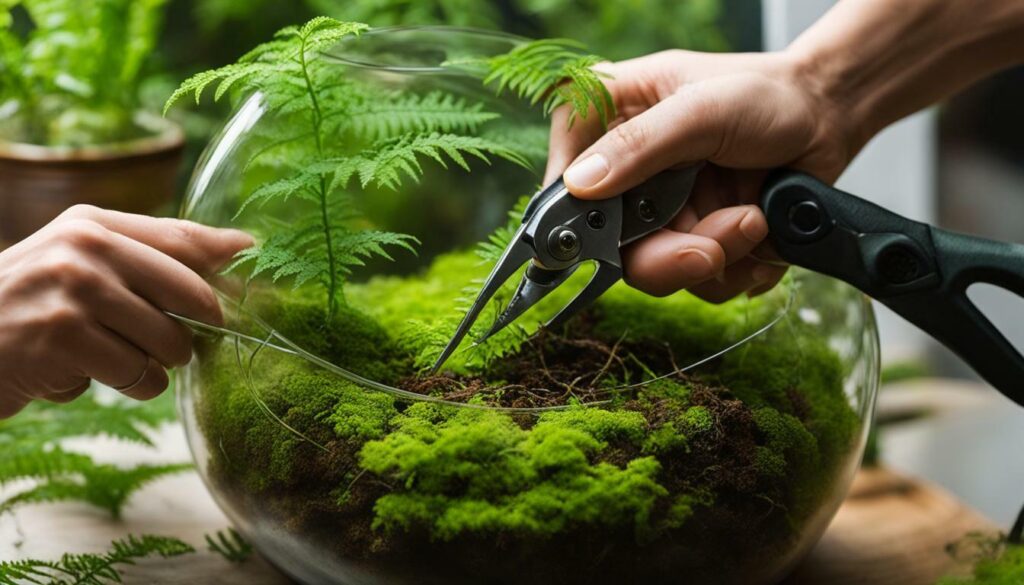
Adequate terrarium maintenance is key to preserving the beauty and longevity of your miniature garden. Terrariums are self-contained ecosystems that require regular attention to thrive. By following a few simple maintenance tips, you can ensure that your terrarium remains healthy and visually appealing.
First and foremost, it’s important to clean the glass of your terrarium regularly to remove dust and fingerprints. A dirty glass can obstruct sunlight, affecting the growth of your plants. Use a soft cloth or sponge and a mild glass cleaner to gently wipe the glass surfaces. Avoid using harsh chemicals or abrasive materials that can damage the glass or harm your plants.
Another essential aspect of terrarium maintenance is removing dead leaves and debris. These can accumulate over time and create a breeding ground for pests and diseases. Carefully inspect your terrarium and pluck out any dead or yellowing leaves. Use a pair of small gardening scissors or tweezers to reach into tight spaces and remove debris. This will not only keep your terrarium looking tidy but also promote the healthy growth of your plants.
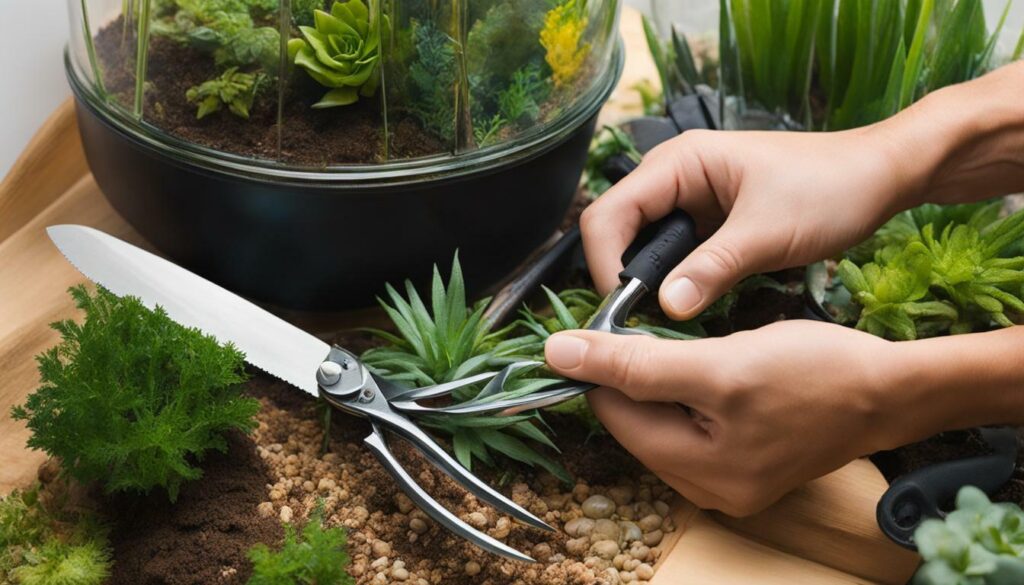
Lastly, pest control is crucial to maintaining a thriving terrarium. Common pests like fungus gnats can quickly infest your miniature garden if left unchecked. To prevent and control these pests, make sure to keep your terrarium clean and free of excess moisture. Avoid overwatering your plants and allow the soil to dry out between waterings. If you notice signs of pests, such as tiny flying insects or damaged leaves, consider using natural pest control methods like neem oil or sticky traps.
| Terrarium Maintenance Tips |
|---|
| Regularly clean the glass of your terrarium to allow maximum sunlight. |
| Remove dead leaves and debris to maintain a tidy appearance and prevent pest infestation. |
| Control pests by maintaining proper watering practices and using natural pest control methods. |
Quick Tips:
- Use a soft cloth or sponge and mild glass cleaner to clean the glass.
- Inspect and remove dead leaves and debris using small gardening scissors or tweezers.
- Prevent pest infestation by avoiding overwatering and using natural pest control methods.
Pruning vs. Trimming: What’s the Difference?
Pruning and trimming are two distinct practices in terrarium care, each serving a specific purpose in maintaining plant health. While both involve the removal of plant material, understanding the difference between pruning and trimming is crucial for effective terrarium maintenance.
Pruning is the deliberate cutting and shaping of plants to encourage healthier growth and improve overall aesthetics. It involves removing dead or dying leaves, stems, and branches that may hinder the plant’s development. Pruning also helps to maintain the desired size and shape of the plant within the terrarium. By removing excess foliage, pruning promotes better air circulation and reduces the risk of diseases and pests.
Trimming, on the other hand, focuses on maintaining the appearance of the terrarium. It involves selectively removing overgrown or unruly parts of the plant to create a neater and more visually pleasing arrangement. Trimming can be done with scissors or pruning shears, and it is often used to shape plants and encourage bushier growth. Regular trimming helps to prevent overcrowding and ensures that all plants in the terrarium receive adequate light and space.
When pruning or trimming your terrarium plants, it is important to use clean and sharp tools to minimize damage and prevent the spread of diseases. Additionally, be mindful of the specific needs and growth habits of each plant species in your terrarium, as different plants may require different pruning and trimming techniques. By mastering the art of pruning and trimming, you can create a beautiful and thriving terrarium that brings joy and tranquility to your space.
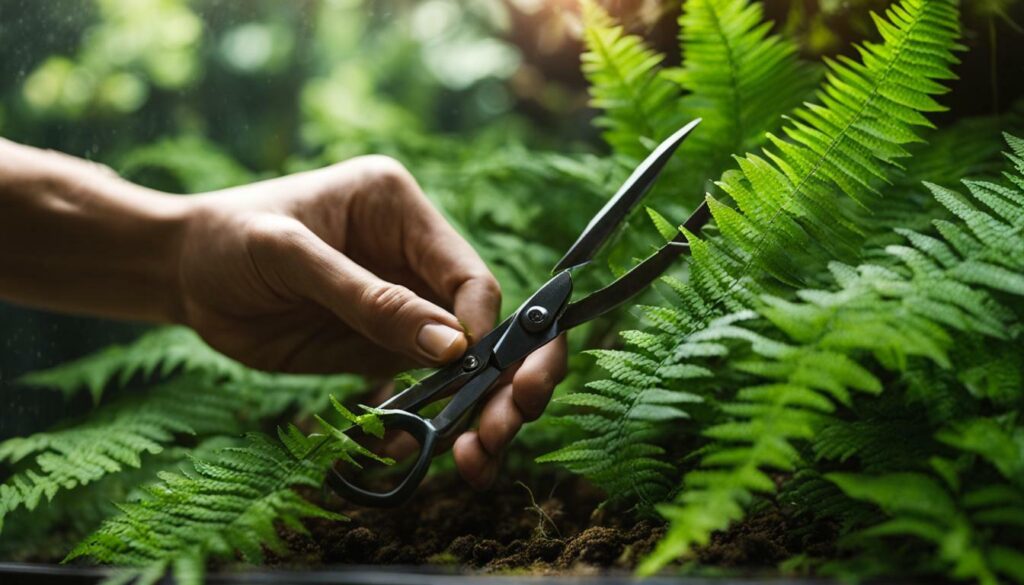
| Pruning | Trimming |
|---|---|
| Removes dead or dying plant material | Creates a neater and more visually appealing appearance |
| Encourages healthier growth | Prevents overcrowding and ensures adequate space |
| Reduces the risk of diseases and pests | Promotes better air circulation |
| Shapes the plant and maintains desired size | Encourages bushier growth |
Removing Sick Plants from Your Terrarium
Sick plants can quickly spread diseases and compromise the overall health of your terrarium. Learn how to spot and remove them effectively. Regular monitoring is essential to identify sick plants. Look for signs of wilting, yellowing leaves, or unusual spots on the foliage. These are often indications of poor health or infestation.
If you notice a sick plant, it’s important to act promptly to prevent further damage. Start by isolating the affected plant from the rest of the terrarium to prevent the disease from spreading. Carefully remove the sick plant from the terrarium, taking care to minimize any disturbance to the surrounding plants.
Once the sick plant has been removed, replace it with a healthy plant that suits the terrarium’s conditions. Consider selecting a plant with similar light and moisture requirements to ensure a seamless transition. By promptly removing sick plants and replacing them, you can maintain the overall health and appearance of your terrarium.
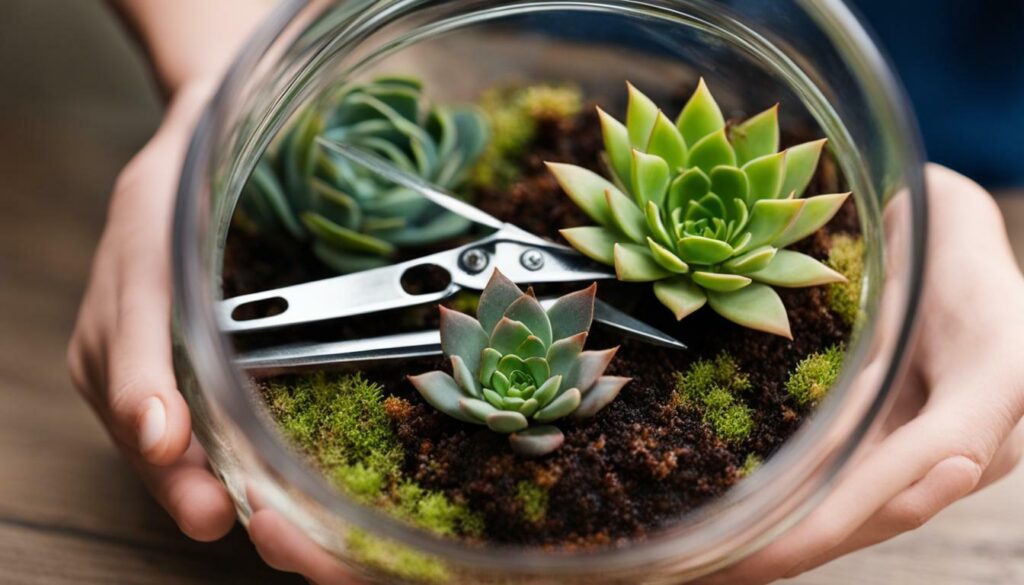
| Symptoms of Sick Plants | Causes | Solutions |
|---|---|---|
| Wilting, drooping leaves | Underwatering | Adjust watering regimen, ensure proper drainage |
| Yellowing leaves | Overwatering | Reduce watering frequency, improve drainage |
| Spots or discoloration on leaves | Fungal or bacterial infections | Remove affected leaves or plants, improve air circulation |
| Sticky residue on leaves | Aphid infestation | Apply organic pest control methods or remove affected plants |
By staying vigilant and promptly addressing any sick plants, you can maintain a healthy and thriving terrarium. Regularly inspect your plants, provide them with proper care, and enjoy the beauty of your miniature indoor garden.
Dealing with Pests in Your Terrarium
Pests can disrupt the delicate balance of your terrarium ecosystem. Discover effective methods to keep them at bay.
One of the key components of successful terrarium care is managing pests. These unwanted visitors can wreak havoc on your mini indoor garden if left unchecked. The good news is, with a few preventive measures and treatment options, you can ensure a pest-free environment for your plants.
First and foremost, it’s important to regularly inspect your terrarium for any signs of pests. Look out for tiny flying insects (like fungus gnats) or crawling critters that may have taken up residence in the soil or on your plants. If you spot any, immediate action is necessary to prevent an infestation.
Here are some effective ways to deal with pests in your terrarium:
- Natural predators: Introduce beneficial insects, such as ladybugs or predatory mites, which feed on common pests like aphids or mites.
- Organic insecticides: Use natural sprays or insecticidal soaps that are safe for your plants and kill pests on contact.
- Neem oil: Neem oil is an effective natural remedy for controlling pests. Mix a few drops with water and spray it on the affected areas.
- Sticky traps: Place sticky traps near your terrarium to catch flying pests. These traps are especially effective against fungus gnats.
Remember, prevention is always better than a cure. Regularly inspect your plants and maintain good hygiene in your terrarium. Remove any dead leaves or decaying plant matter promptly, as they can attract pests. Additionally, ensure proper ventilation to discourage the buildup of moisture, which can create an ideal breeding ground for pests.
| Pest | Treatment |
|---|---|
| Fungus gnats | Sticky traps, a hydrogen peroxide solution, or beneficial nematodes |
| Aphids | Insecticidal soap, neem oil, or ladybugs |
| Spider mites | Neem oil solution or predatory mites |
| Mealybugs | Isopropyl alcohol, insecticidal soap, or ladybugs |
By implementing these practices and being proactive in your terrarium care routine, you can effectively prevent and manage pest issues. With a little effort, you can keep your terrarium thriving and enjoy the beauty of your mini indoor paradise.
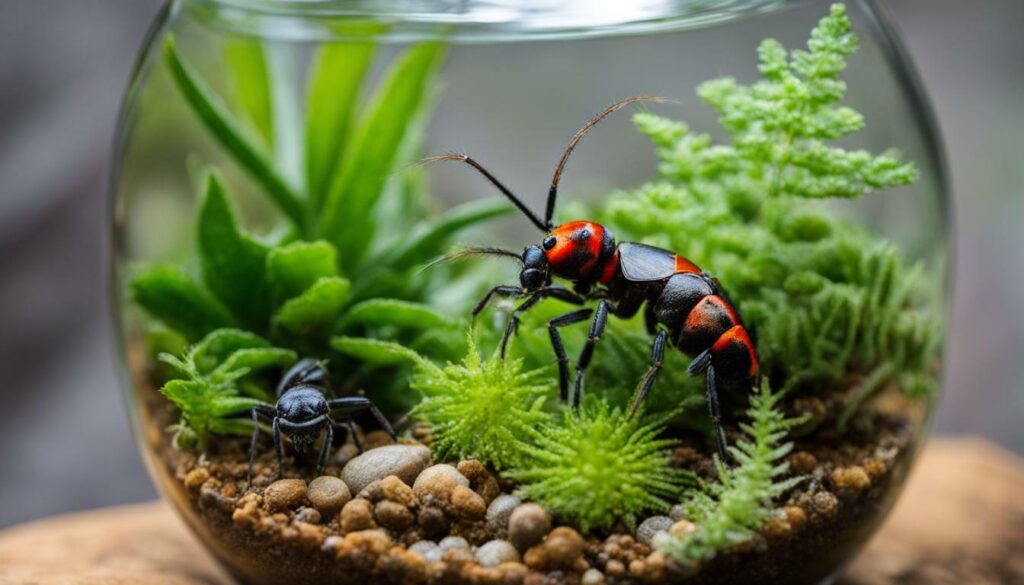
Watering is a crucial aspect of terrarium care, but getting it right can be a challenge. Learn the best watering techniques for your specific terrarium type to ensure the health and longevity of your plants.
Open Terrariums
Open terrariums, as the name suggests, have an opening that allows for air circulation. The watering requirements for open terrariums are different from their closed counterparts. When watering an open terrarium, it is important to provide enough moisture without overwatering.
One effective method is the “soak and dry” technique. This involves thoroughly watering the terrarium until the soil is moist, but not waterlogged. Allow the soil to dry out completely before watering again. For most open terrariums, this usually means watering once a week, but it may vary depending on the environment and plant species.
Tip: Monitor the moisture level by gently pressing your finger an inch into the soil. If it feels dry, it’s time to water.
Closed Terrariums
Closed terrariums create a self-contained environment, where the plants recycle the moisture through transpiration. They require less frequent watering compared to open terrariums.
The best approach for watering closed terrariums is the “bottom watering” method. Place a small amount of water in the tray or dish beneath the terrarium and allow the plants to absorb the water through the drainage holes in the container. This prevents water from directly contacting the leaves and reduces the risk of mold or fungus growth.
Monitor the moisture level in the soil and the condensation on the glass. If the condensation is excessive or the soil feels too wet, it may indicate overwatering. Adjust the amount of water accordingly to maintain a balanced environment.
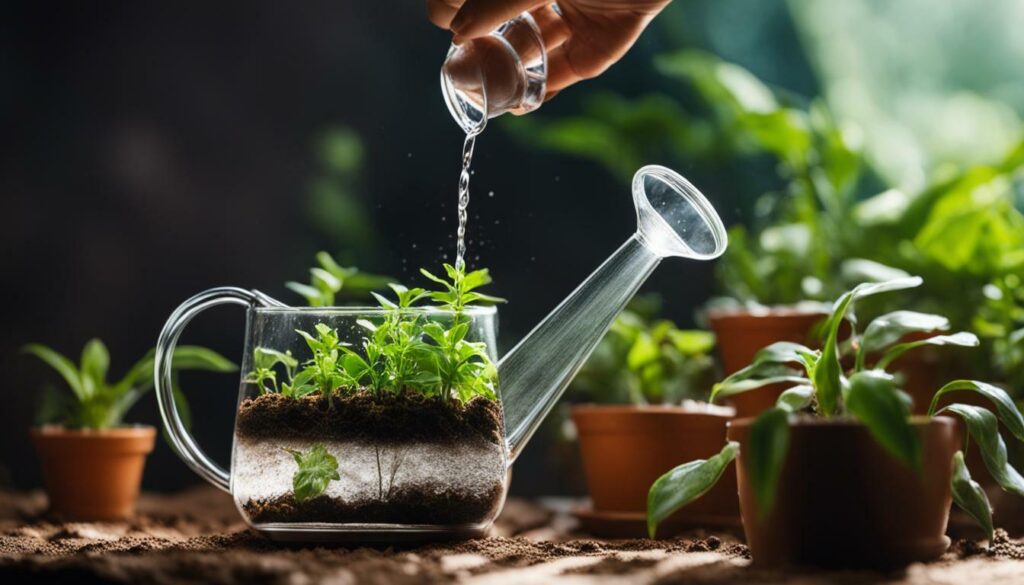
| Terrarium Type | Watering Technique |
|---|---|
| Open Terrarium | Soak and dry method |
| Closed Terrarium | Bottom watering |
To summarize, watering techniques for terrariums depend on the type of terrarium you have. Open terrariums benefit from the soak and dry technique, while closed terrariums thrive through bottom watering. Remember to observe the moisture levels and adjust your watering schedule accordingly. With proper watering techniques, your terrarium plants will flourish and create a stunning miniature ecosystem in your home.
Maintaining the Aesthetics of Your Terrarium
A well-maintained terrarium not only thrives but also adds beauty and charm to any space. Discover how to maintain the aesthetics of your terrarium with these terrarium pruning, trimming, and maintenance tips.
1. Pruning and Trimming: Regular pruning and trimming are essential to keep your terrarium plants in shape. Use clean, sharp pruning shears to remove any dead or overgrown foliage. This will not only improve the appearance of your terrarium but also promote healthy growth. Remember to prune selectively and with care, ensuring you do not disturb the overall balance and harmony of the terrarium.
2. Shaping and Styling: Get creative with the design of your terrarium by shaping and styling your plants. Consider using wires or stakes to support climbing plants or create interesting shapes. You can also use natural elements like rocks, moss, and driftwood to add texture and interest to your terrarium. Experiment with different arrangements and find a style that suits your taste and complements your space.
3. Managing Growth: As your terrarium plants grow, it’s important to manage their growth to maintain the desired aesthetic. Regularly trim back any excessive growth to prevent overcrowding and ensure each plant has ample space to thrive. Be mindful of the specific growth habits of each plant and adjust your pruning and trimming techniques accordingly.
Expert Tip:
A well-maintained terrarium not only thrives but also adds beauty and charm to any space.
4. Cleaning and Maintenance: To keep your terrarium looking its best, make sure to clean the glass regularly. Use a soft cloth or sponge and a mild cleaning solution to remove any dust or smudges. Additionally, remove any dead leaves or debris from the terrarium to maintain a clean and tidy appearance.
Remember, maintaining the aesthetics of your terrarium is an ongoing process. Regular pruning, trimming, and attention to detail will ensure that your terrarium remains a stunning focal point in your home or office.
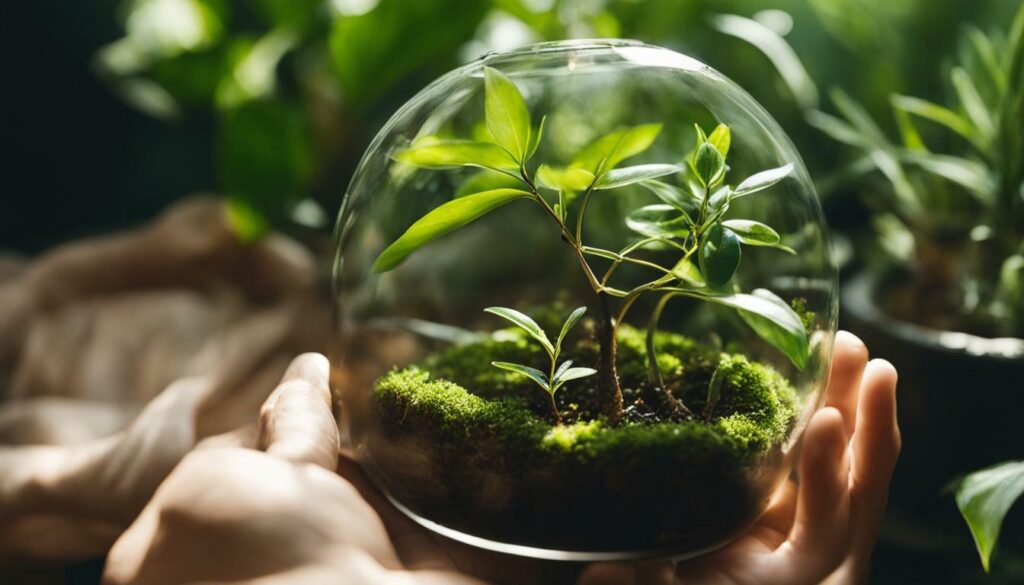
| Terrarium Pruning Tips | Terrarium Trimming Tips |
|---|---|
| 1. Prune selectively and with care. | 1. Trim back excessive growth to prevent overcrowding. |
| 2. Use clean, sharp pruning shears. | 2. Choose the right tools for trimming, such as scissors or bonsai shears. |
| 3. Remove dead or yellowing leaves. | 3. Trim off any brown or damaged foliage. |
| 4. Keep the overall balance and harmony of the terrarium in mind. | 4. Adjust the trimming frequency based on the growth rate of your plants. |
What are the Best Pruning and Trimming Tips for Terrarium Care?
When it comes to caring for your terrarium, mastering the art of pruning is essential. Use precision tools to trim overgrown plants, and pay attention to individual needs. Regularly remove dead leaves and branches to maintain a healthy environment. These master terrarium pruning tips will help keep your miniature garden thriving.
Conclusion
With the right techniques and regular maintenance, you can master the art of pruning and trimming your terrarium, creating a thriving ecosystem that brings joy and tranquility to your space.
Terrariums are not only low-maintenance but also create little landscapes for your house plants. Whether you have a closed or open terrarium, it’s crucial to understand their specific positioning and lighting requirements, as they can vary.
Proper watering is essential for terrarium care. Open terrariums typically require weekly watering, while closed terrariums are self-watering. It’s important to strike the right balance to avoid overwatering or underwatering your plants.
Pruning and trimming play a vital role in maintaining the appearance of your terrarium. Regularly removing dead leaves and shaping the plants will ensure that your terrarium remains aesthetically pleasing. Additionally, it’s crucial to identify and remove any sick plants promptly to prevent the spread of diseases.
Furthermore, terrarium maintenance goes beyond pruning and trimming. Cleaning the glass regularly will keep your terrarium looking crystal clear, while dealing with common pests like fungus gnats is essential to keep your plants healthy. By following these maintenance tips, you can create a beautiful and thriving terrarium that enhances the ambiance of your space.
So, embrace the art of terrarium care and enjoy the benefits of a beautifully curated ecosystem in your home or office. With a little knowledge and dedication, you can create a serene and visually captivating terrarium that brings nature indoors.
FAQ
What is a terrarium?
A terrarium is a miniature garden encased in glass, typically containing house plants. It creates a little ecosystem for the plants and requires minimal maintenance.
What are the different types of terrariums?
There are open terrariums and closed terrariums. Open terrariums allow for airflow and require weekly watering, while closed terrariums are self-watering and require less frequent watering.
How often should I water my terrarium?
For open terrariums, it is recommended to water weekly, making sure the soil is moist but not waterlogged. Closed terrariums require less frequent watering, as the moisture is retained within the container.
How do I prune and trim my terrarium?
To prune and trim a terrarium, use clean, sharp scissors or pruning shears. Remove any dead or yellowing leaves, trim overgrown stems, and shape the plants as desired.
What should I do with sick plants in my terrarium?
If you notice any sick plants in your terrarium, it is best to remove and replace them promptly. This will prevent the spread of disease to other plants in the terrarium.
How do I clean the glass of my terrarium?
To clean the glass of your terrarium, use a soft cloth or sponge and a mild glass cleaner. Avoid using harsh chemicals that could harm the plants.
How do I deal with pests like fungus gnats in my terrarium?
To deal with pests like fungus gnats, try using sticky traps or a natural insecticide. It is also important to maintain proper watering practices to prevent the growth of fungus gnats.

